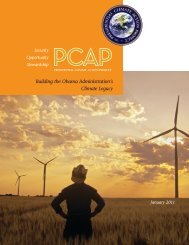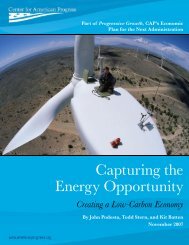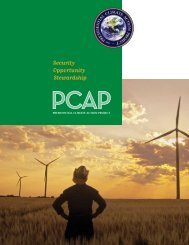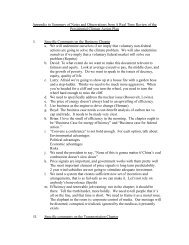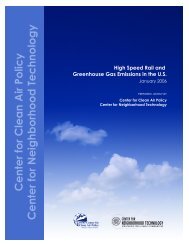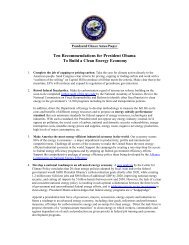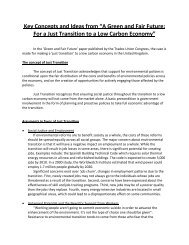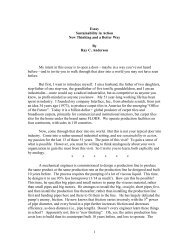PCAP - Presidential Climate Action Project
PCAP - Presidential Climate Action Project
PCAP - Presidential Climate Action Project
- No tags were found...
You also want an ePaper? Increase the reach of your titles
YUMPU automatically turns print PDFs into web optimized ePapers that Google loves.
I. IntroductionThis report is a follow-up to a previous report issued by the Center for Energy andEnvironmental Security (CEES) in February 2008, The Boundaries of Executive Authority:Using Executive Orders to Implement Federal <strong>Climate</strong> Change Policy. 1 In that report wesummarized and brought together in one place the most applicable guidance on the legalboundaries of executive authority, with a focus on the use of executive orders to implementappropriate provisions of the <strong>Presidential</strong> <strong>Climate</strong> <strong>Action</strong> Plan. The <strong>Presidential</strong> <strong>Climate</strong> <strong>Action</strong>Plan, developed by the <strong>Presidential</strong> <strong>Climate</strong> <strong>Action</strong> <strong>Project</strong> (<strong>PCAP</strong>), is a comprehensive actionplan to address climate change nationally and is the result of combined expertise of respectedgroups and individuals from around the country who are from science, policy, legal and otherbackgrounds. 2The <strong>PCAP</strong> Report transforms policies into action items that can be taken at the federal level by,for example, Congress or the President to address climate change. <strong>PCAP</strong> has identified specificaction items from their national plan as priorities which we will refer to as proposals. Theseserve as examples of the actions the next President can take to address climate change. In thisreport, CEES evaluates implementation of each of these priority proposals by executive order orother executive directive by identifying the relevant legal authority or authorities that areapplicable to each specific proposal, analyzing these authorities, and then evaluating eachproposal in terms of implementation by executive directive based on an assessment of a numberof factors which are described below.The Boundaries Report delineates the authority of the President to use executive directives ingeneral terms and also addresses topics of special interest to climate action policy, such asregulating greenhouse gas emissions (GHGs) under the Clean Air Act and supporting climatemitigation through federal procurement. The legal analysis included in the Boundaries Reportwill be referenced where applicable but not repeated in this report. The two reports should beconsidered together as companion reports.Throughout this report The Boundaries of Executive Authority: Using Executive Orders toImplement Federal <strong>Climate</strong> Change Policy will be referenced as the “Boundaries Report” andthe <strong>Presidential</strong> <strong>Climate</strong> <strong>Action</strong> Plan will be referenced as the “<strong>PCAP</strong> Report.”A. Overview of ReportThis report begins with a summary of the general authority to address climate change. Chapter IIincludes an analysis of federal statutes, executive directives (executive orders and proclamationsonly), and treaties (primarily the United Nations Framework Convention on <strong>Climate</strong> Change)that explicitly address global warming, climate change or greenhouse gases. Section II includesan evaluation of each specific priority proposal. The proposals are grouped into six sections as1 The Boundaries Report, commissioned by the <strong>Presidential</strong> <strong>Climate</strong> <strong>Action</strong> <strong>Project</strong>, is available athttp://www.colorado.edu/law/eesi/Boundaries_Executive_Authority.pdf.2 The <strong>Presidential</strong> <strong>Climate</strong> <strong>Action</strong> Plan is available at http://www.climateactionproject.com/index.php.CEES 1 | P age



